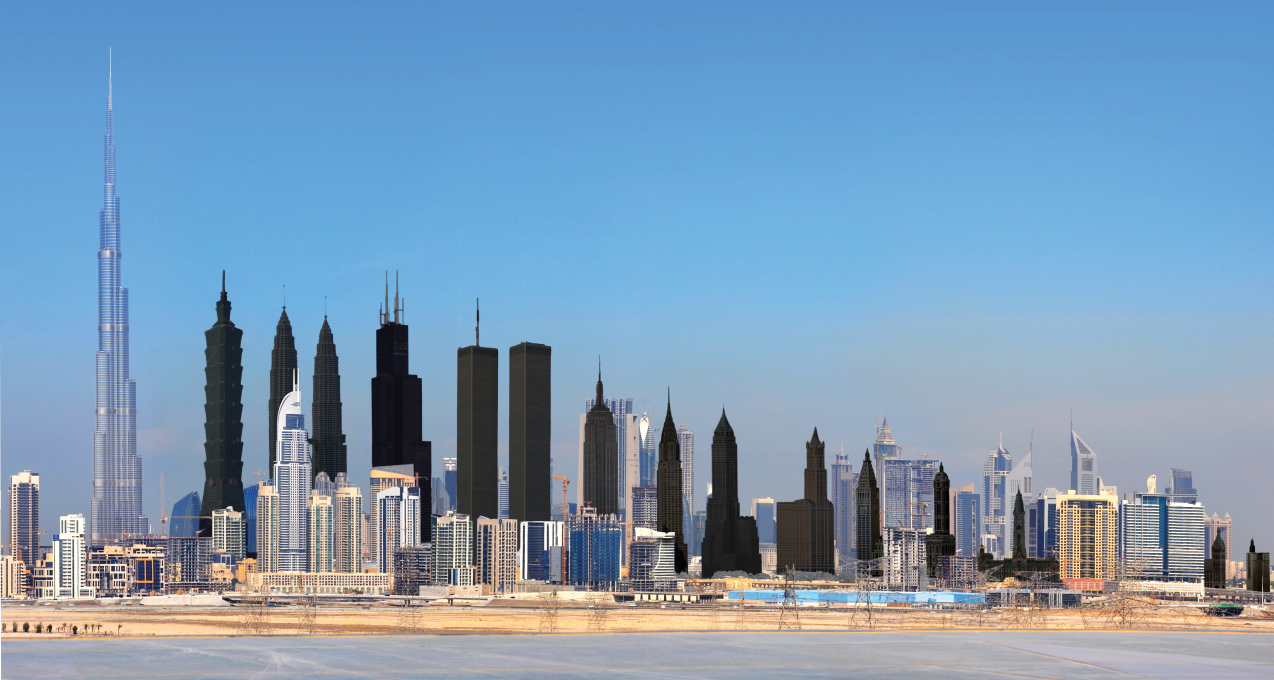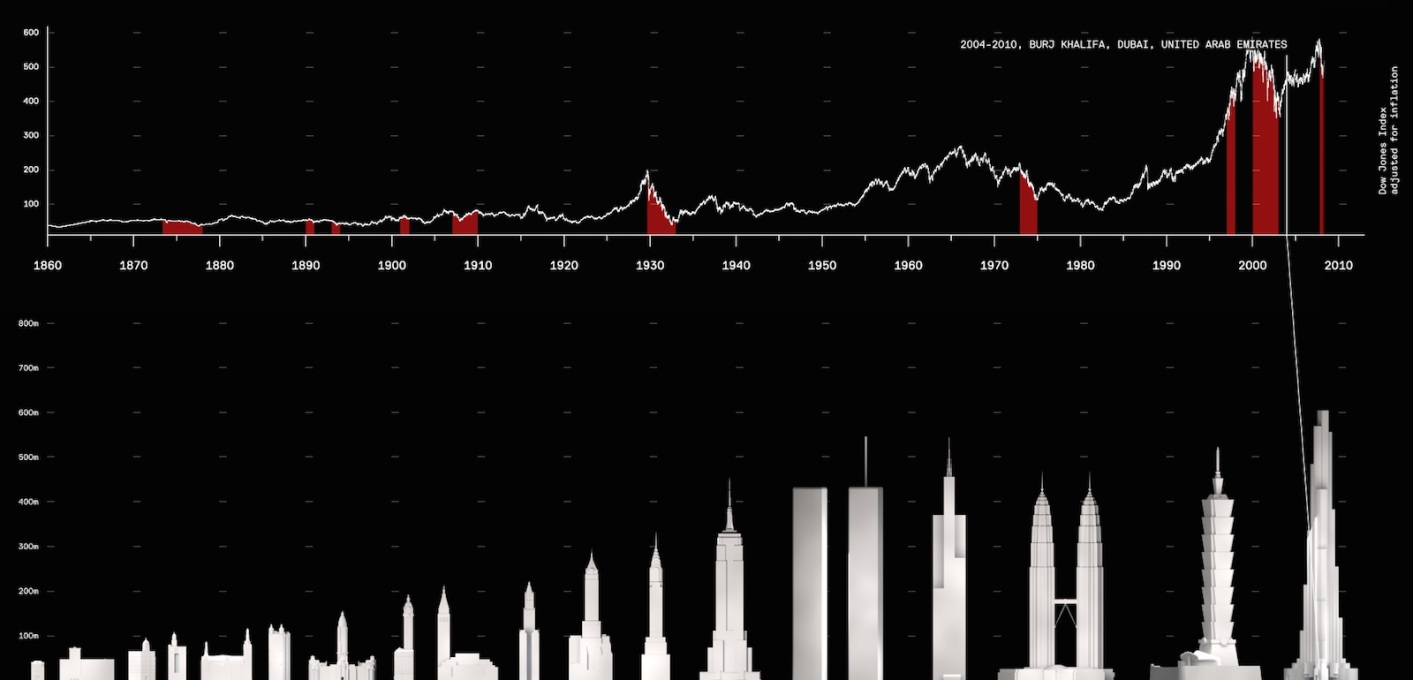Artist Jonas Staal’s video work “Monument to Capital” (2013) was inspired by the uncanny inverse correlation between the giddy rise of monster towers and the precipitous fall of stockmarkets revealed by the annual Skyscraper Index, as published by the British multinational bank Barclays. Here in a previously unpublished “script” for the two parts of the work, Staal describes architecture’s role as an unconscious illustrator of global economics, and proposes radical architectural reversion therapy to counter the monumental commemoration of money that all the tower-building over the years has become.
Part I: The World without Author: Trauma as Currency
The British multinational bank Barclays, which provides financial services worldwide, annually publishes its Skyscraper Index. First developed in 1999, it shows – according to the 2012 edition – the “unhealthy correlation between construction of the next world’s tallest building and an impending financial crisis: New York 1930; Chicago 1974; Kuala Lumpar 1997 and Dubai 2010”.
From the 142 foot high Equitable Life Building in New York built in 1873 at the beginning of what became known as the Long Depression, to the 2,717 foot Burj Khalifa built in 2007 at the onset of our own contemporary Great Recession, Barclays’s research shows that when markets go down, skyscrapers rise up. Or, conversely, whenever the world’s highest buildings pop up, the Dow Jones plunges. The Skyscraper Index thus shows a direct correlation between the world’s highest buildings and its deepest crises and may therefore be considered a unique form of capitalist self-critique.
The skyscraper is a monumentalisation of capital, a desperate attempt to invoke a certain materiality of contemporary capital that has long been lost, ever since the gold standard was abolished in 1971. The skyscraper-phallus is the obscene symbol of capital, intimidating its subjects through an excessive culmination of concrete and steel, as if this absurd totem could restore the relationship between power and concrete, material wealth.
Capitalism’s complete loss of control over its own dynamics, its complete reliance on an excess of surplus value, results in a reinstitutionalisation of some form of material understanding of value and possession. The building of the skyscraper is a form of exorcism, a shock therapy to recover from capitalism’s continuous self-alienation. But instead of implementing any kind of new stable material standard, the tallest buildings of the world herald precisely the opposite: they only inflate capitalist anxiety. By the time its buildings reach the top, capital is lost. And back on the ground, society falls into poverty. Thus the anxiety resulting from the loss of capital is accompanied by a total schizophrenia: to make capital radically present, it should be permanently out of reach.
In cities like Johannesburg, where Barclays itself inhabits one of the most prominent skyscrapers, social deprivation is at its highest. Its skyscrapers function as a screen preventing one from ever realising how bad the situation really is. Even though capital has evidently been lost, the towers that remain still project some form of symbolic prosperity preventing us from confronting the actual levels of poverty and inequality. They have stored parts of capital’s “ghost” as it fled our societies, effectively suppressing our actual trauma of the loss we experience: our money is supposedly still in the bank; it will just never come out. We adore our skyscrapers, landmarks waiting for prosperity and growth to return, as magically as it came before. These skyscrapers, this collection of the tallest buildings in the world, form our very own “Monument to Capital”. It makes “solid” what would otherwise melt into air, yet air is all that remains once we are faced with the fact that these impenetrable ghost banks hold nothing but our traumas as asset.
The Barclays Skyscraper Index thus provides us with insight into the conditions underlying this global Monument to Capital. Today, we tend to understand the history of the tallest buildings in the world as an architectural history, focusing on the aesthetic specificities of each of their visual manifestations and the specific social and political conditions of the country in which they arose. But now that our economies have lost all autonomy in a global exchange of capital, this approach, taking as its departure point the unique aesthetic character of each of these buildings, is clearly delusional.
––
The French sociologist and philosopher Jacques Ellul argued in his 1967 book The Technological Society that the end of the second Industrial Revolution had resulted in an increasingly global technological society. He went on to propose in a later book Propaganda – The Formation Of Men’s Attitudes (1973) the analysis of the technological construct of our contemporary cities as a form of sociological propaganda. This meant that instead of focusing on the publicly proclaimed intentions behind the construction of the highest buildings in the world, we should focus on their actual morphology. The question is not what the buildings are supposed to mean, but how they perform their meaning. Following Ellul’s line of thought, we should consider the city as ideology in action. This is the real meaning of Barclays’ Skyscraper Index. As such, their research into the highest buildings of the world is strangely Ellulian in nature; by merely looking at the correlation between the highest buildings in the world and financial crises, their collective morphology is that of an assemblage of seemingly decontextualized architectural units, each part of one and the same Monument to Capital.
By approaching Barclays’s Skyscraper Index through Ellul we are able to map out the global pulse formed by the correlation between collapsing stock indices and the rise of the highest skyscrapers. It reveals the organism of our cities, the way they contain and display our hopes and anxieties. Hold the Dow Jones Index upside down, and you would be able to distinguish each of the highest buildings in the world based in the chart’s peaks. Each peak, an inverted meltdown, representing its accompanying tower.
Now the fundamental question arises concerning the Monument to Capital is: who is the author? If the reversed Dow Jones Index shows the perfect global blueprint of the Monument to Capital, than what is the architect more than an illustrator of an already defined economic model? The pulse of today’s world. Asking about its authorship would be like asking who decides about our heart beat.
When we allow ourselves to visualise the Monument to Capital, we are staring at a worldwide design for a global monumental commemoration of capital that has moved out of our reach. The Monument to Capital memorialises a world without author, a capital without capital.
Part II: Historicising the Future: A Proposal

Currently, the highest building in the world is the Burj Khalifa in Dubai, built at the peak of the financial crisis of 2007. It stands 2,717 feet tall, but it is already confronted with an ongoing series of proposals in other countries to replace it as the highest building in the world. In Changsha, China, there is a plan is to create a new skyscraper 2,749 feet high. In Madinat al-Hareer, Kuwait, a skyscraper entitled “Burj Mubarak Al-Kabir” is planned to reach 3,284 feet. In Jeddah, Saudi-Arabia the “Kingdom Tower” is projected to top out at 5,280 feet…
The competition between countries to shape this expansion of the global Monument to Capital has in itself become completely speculative, with new, taller designs constantly being announced without any one of them actually being built. In itself, the Monument to Capital has opened a new speculative market, which responds to the surplus value of each newly announced architectural proposal, without any of them ever materialising themselves. Whereas the original Monument to Capital was an impotent attempt to reinstall a material standard into its own market, today the plans for the tallest buildings in the world participate in an expansion of that very same market. The future of the Monument to Capital is thus one of a surplus architecture, a history of buildings without buildings.
To force a turning point, I propose to build against growth: to start building downward. Step by step, from the Burj Khalifa on, we formalise the Monument to Capital and force history to a halt: a breakthrough out of history, against history:
Next to the Burj Khalifa we build the Taipei 101.
Next to Taipei 101 we build the Petronas Towers.
Next to the Petronas Towers we build the Sears Tower.
Next to the Sears Tower we build the World Trade Center.
Next to the World Trade Center we build the Empire State Building.
Next to the Empire State Building we build the Chrysler Building.
Next to the Chrysler Building we build 40 Wall Street.
Next to the 40 Wall Street we build the Woolworth Building.
Next to the Woolworth Building we build the Metropolitan Life Building.
Next to the Metropolitan Life Building we build the Singer Building.
Next to the Singer Building we built Philadelphia City Hall.
Next to Philadelphia City Hall we build the Park Row Building.
Next to the Park Row Building we build the Milwaukee City Hall.
Next to Milwaukee City Hall we build Manhattan Life Insurance Building.
Next to Manhattan Life Insurance Building we build the New York World Building.
Next to the New York World Building we build the Auditorium Building.
Next to the Auditorium Building we build the Equitable Life Building.
We complete the history commemorated by the current Monument to Capital by extending its history into the future.
– Jonas Staal is a Dutch visual artist and founder of the artistic and political organisation New World Summit. His work deals with the relationship between art, politics, and ideology.
jonasstaal.nl
newworldsummit.eu





